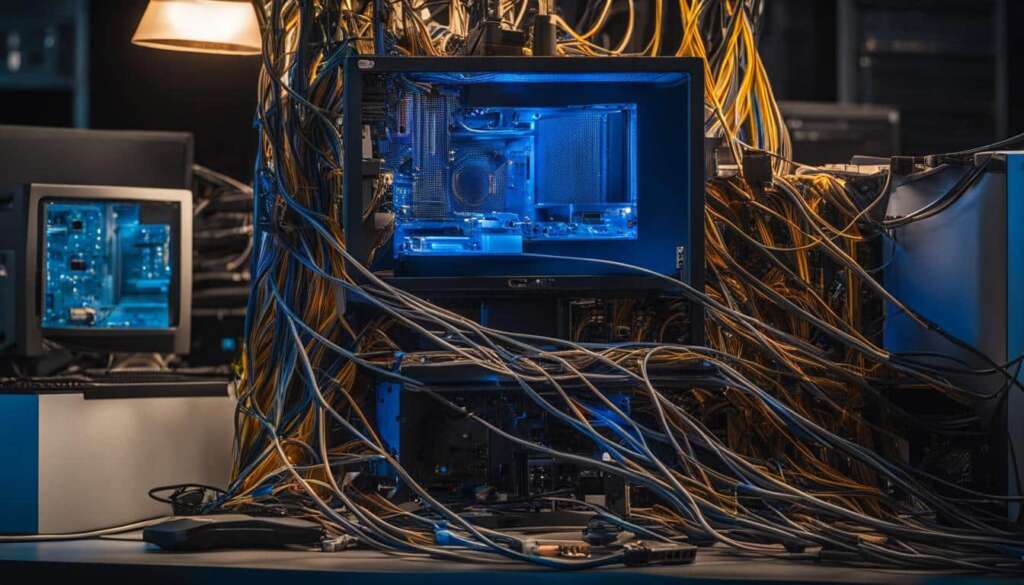Table of Contents
Welcome to our step-by-step guide on how to run diagnostics on your PC and troubleshoot any issues affecting its performance. Whether you’re experiencing sluggishness, system crashes, or other performance-related problems, running diagnostics can help you uncover the underlying causes and take appropriate actions to resolve them.
So, how do you run diagnostics on your PC? The process is simpler than you might think. Follow these easy steps to get started:
- Access the Windows settings by navigating to the Troubleshoot section.
- On Windows 11, go to Settings > System > Troubleshoot. On Windows 10, go to Settings > Update & Security > Troubleshoot.
- Choose from various troubleshooters available for specific issues like Bluetooth, keyboard, Windows Update, and network and internet problems.
- Utilize built-in Windows tools such as Windows Memory Diagnostic to test your RAM and the Reliability Monitor to track system events.
- Consider using hardware-specific apps like the Intel Processor Diagnostic Tool to diagnose and optimize hardware components.
- Review the results of each diagnostic tool and take appropriate actions to resolve any identified issues.
Running diagnostics on your PC can significantly improve system performance and ensure a smooth computing experience. By identifying and resolving underlying issues promptly, you can optimize your PC’s performance and enhance its overall reliability.
Built-in Diagnostics Tools on Windows 10 and 11
Windows 10 and 11 offer a variety of built-in diagnostics tools designed to troubleshoot common issues, ensure system stability, and identify hardware and software problems. Accessible through the Control Panel or Settings app, these tools provide valuable insights and options for resolving issues. Let’s explore some key built-in diagnostics tools:
Device Manager
The Device Manager is an essential tool for managing and diagnosing hardware devices on your Windows 10 or 11 system. With Device Manager, you can view and control the hardware components, update drivers, and troubleshoot device-related problems.
Event Viewer
The Event Viewer provides detailed information about system events on your Windows 10 or 11 PC. It logs various events, including error messages, warnings, and informational notifications. By analyzing the events in the Event Viewer, you can identify patterns and potential issues affecting your system.
Performance Monitor
The Performance Monitor allows you to monitor system performance and resource usage on your Windows 10 or 11 PC. With this tool, you can track CPU, memory, disk, and network usage, as well as view real-time graphs and generate reports. Monitoring system performance can help you detect bottlenecks, optimize resource allocation, and enhance overall system stability.
Windows Security
Windows Security is a built-in antivirus and malware protection tool for Windows 10 and 11. It offers comprehensive security features, including real-time threat detection, firewall settings, and automatic updates. Regularly scanning your system with Windows Security can help prevent and resolve security-related issues.
These built-in diagnostics tools on Windows 10 and 11 empower users to proactively troubleshoot common issues, ensure system stability, and optimize the performance of their PCs. By leveraging these tools, you can diagnose hardware and software problems, fine-tune system settings, and maintain a smooth and trouble-free computing experience.
Advanced Diagnostics Tools for Windows 10
In addition to the built-in diagnostics tools, Windows 10 offers advanced diagnostics tools for a more comprehensive analysis and troubleshooting experience. These tools provide deeper insights into your system’s performance, hardware health, and overall system stability.
One popular advanced diagnostics tool is MemTest86, which rigorously tests your RAM for errors. This tool ensures that your system’s memory is functioning optimally, preventing any performance issues caused by faulty RAM.
CrystalDiskInfo is another valuable tool that monitors the health and performance of your hard drives or SSDs, allowing you to identify any potential hardware issues before they become major problems. By regularly checking your storage devices, you can maintain their performance and prevent data loss.
If you’re looking for detailed information about your hardware components, HWiNFO is an excellent choice. This tool provides comprehensive and real-time data about your computer’s hardware, including temperature, usage, and voltages. By understanding your hardware’s status, you can optimize its performance and ensure its longevity.
Malwarebytes is another advanced diagnostics tool that goes beyond the built-in Windows security features. It scans your system for malware and viruses, protecting your computer from potential threats and ensuring a secure browsing and computing experience.
By utilizing these advanced diagnostics tools, you can gain valuable insights into your system, diagnose potential issues, and take appropriate actions to optimize performance and ensure hardware reliability. Regularly running these diagnostics tools as part of your system maintenance routine will help you identify and resolve any issues, resulting in a smooth and trouble-free experience with your Windows 10 computer.
Comparing Advanced Diagnostics Tools
| Diagnostics Tool | Main Features |
|---|---|
| MemTest86 | Thoroughly tests RAM for errors |
| CrystalDiskInfo | Monitors health and performance of hard drives or SSDs |
| HWiNFO | Provides detailed information about hardware components |
| Malwarebytes | Scans for malware and viruses |
Best Practices for Running Diagnostics on Windows 10
When it comes to running diagnostics on your Windows 10 system, following best practices is essential for optimal performance and a trouble-free experience. Regular maintenance and diagnostics are key to keeping your system optimized and preventing any potential issues from arising.
One of the first best practices is to establish a regular maintenance and diagnostics schedule. By dedicating time to perform routine checks and scans, you can identify and address any underlying problems before they impact your system’s performance.
Another crucial aspect is to ensure that your diagnostics tools are always up to date. Regularly update your antivirus software, system scanners, and driver update utilities to stay equipped with the latest features, bug fixes, and security patches. This proactive approach will provide you with the most reliable and effective diagnostics capabilities.
In certain cases, you may need to utilize external diagnostic software for specific purposes or in-depth analysis. However, it’s important to choose reputable tools that align with your needs and requirements. Conduct thorough research and seek recommendations to ensure the software you use is reliable and trustworthy.
By following these best practices, you can effectively diagnose and resolve issues, ensuring a smooth and trouble-free experience with your Windows 10 system. Regular maintenance, updated diagnostics tools, and judicious selection of external software will help you optimize performance and keep your system running smoothly.
FAQ
How do I run diagnostics on my PC?
To run diagnostics on your PC, access the Windows settings and navigate to the Troubleshoot section. From there, you can choose from various troubleshooters for specific problems like Bluetooth, keyboard, Windows Update, and network and internet issues. You can also use built-in Windows tools like Windows Memory Diagnostic and the Reliability Monitor.
What are the built-in diagnostics tools on Windows 10 and 11?
Windows 10 and 11 provide a range of built-in diagnostics tools, including Device Manager, Event Viewer, Performance Monitor, and Windows Security. These tools help manage and diagnose hardware devices, display system event information, monitor system performance and resource usage, and provide antivirus and malware protection.
Are there advanced diagnostics tools available for Windows 10?
Yes, there are advanced diagnostics tools available for Windows 10. Some popular options include MemTest86 for thorough RAM testing, CrystalDiskInfo for monitoring hard drive and SSD health and performance, HWiNFO for detailed hardware component information, and Malwarebytes for scanning for malware and viruses.
What are the best practices for running diagnostics on Windows 10?
To make the most of your diagnostics efforts on Windows 10, establish a regular maintenance and diagnostics schedule, update your diagnostics tools including antivirus software and driver update utilities, and consider using reputable external diagnostic software based on your needs and requirements.







